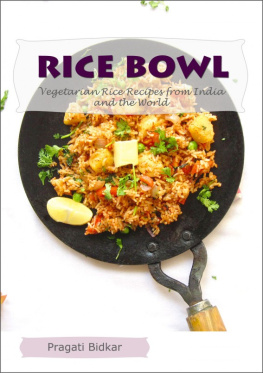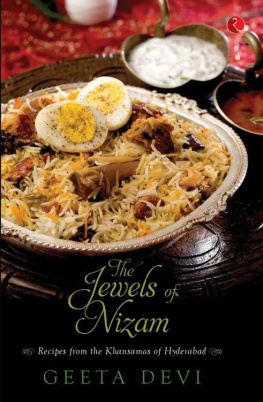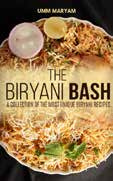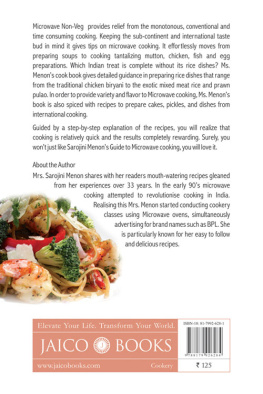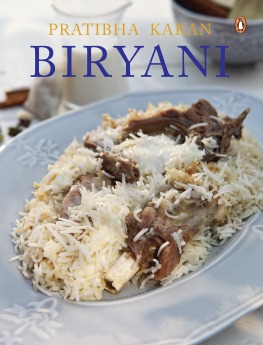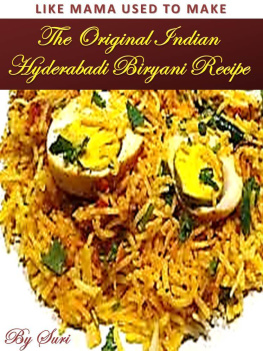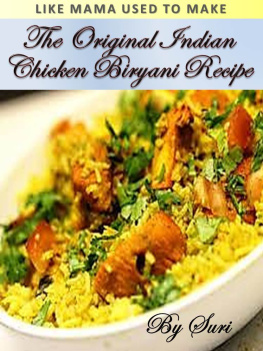

Notion Press
Old No. 38, New No. 6
McNichols Road, Chetpet
Chennai - 600 031
First Published by Notion Press 2016
Copyright Tanuj Singh, Varuna Mathur 2016
All Rights Reserved.
ISBN 978-0-9975577-2-5
This book has been published with all efforts taken to make the material error-free after the consent of the author. However, the author and the publisher do not assume and hereby disclaim any liability to any party for any loss, damage, or disruption caused by errors or omissions, whether such errors or omissions result from negligence, accident, or any other cause.
No part of this book may be used, reproduced in any manner whatsoever without written permission from the author, except in the case of brief quotations embodied in critical articles and reviews.
Dedication
According to scientists, food that we believe has been prepared with tender love and care (TLC) always tastes better. We all have memories of our grandmothers and moms cooking meals that we remember through our adult years. Their cooking was simple and prepared with what was available at the time. But since the food was cooked and made with all their heart; it has always put a smile on your face. I have always tried imbibing this life lesson, something I fall back on often. So, I dedicate this book to all the women who have influenced our lives; cooking great food.
The fondest family memories are made when gathered around the table kitchen with friends, family, who is always the reason to have a dinner party.
To Mom and Dad, its impossible to thank you adequately for everything youve done. My dad, who told me the stories that really matter and my mom, who taught me to remember them.
Special thanks to my wife Anamika for standing beside me throughout my career and writing this book.
My son, Aryan, who is just about the best child a dad could hope for: happy, loving, and fun to be with.
My brother, Anuj, my first guinea pig, who made meals great just by being there.
And lastly, for all of my wonderful friends old and new-thanks for always being there for me! Thanks to all my friends for sharing my happiness when starting this project and following with encouragement when it seemed too difficult to be completed.
Finally, this dedication would not be complete without a very special thank you to Varuna, my co-author & recipe writer.
Thank God for dirty dishes, they have a tale to tell. While others may go hungry, were eating very well. With home and health and happiness, I shouldnt want to fuss For by the stack of evidence, Gods been good to us.
Love & Luck: Tanuj
Cooking is love made visible! And so is the purpose behind so many wonderful people around us who cook and serve us their love. To fulfill and strengthen such a heavenly relationship, I hereby dedicate this book to some very special people in my life.
To my husband, Pranay Mathur, for being my support in every walk of this journey! A special thanks to you for believing in me! To my daughter, Prisha, the best gift of God in this life!
To my parents, my inspiration and strength, because nothing can match what you both have done for me! Whatever I am today, I owe it to you.
Warm and deeply felt thanks to my aunt, Vinita Sinha - for introducing me with food and teaching me that first cup of tea!
Special thanks to Tanuj, my co-author! I remember the day when you proposed this idea to me and here we are today! It wouldnt have been possible without you!
Lastly, I dedicate this book to all those food lovers, especially biryani lovers, who are crazy for delicious cooking can wander directions in search of some amazing dishes. I hope this book helps them reveal the chef inside them.
After all, People who love to eat are always the best people. Julia Child
Cheers! Varuna
Contents
Foreword
Biryani - a dish, not indebted to any introduction, not bounded by territories and certainly not limited by provenance. It is one dish which not only speaks to our taste buds on a platter with flavors gathered from in and around Indian subcontinent and the world outside, but also reminds us of the unique shades it comes with, that are gathered from different cultures and regions.
As I write this section of the book, I wonder what is that first thing that comes to our mind when we think of Biryani probably a Degchi or a hug e Handi with a combination of fine quality rice along with meat and spices cooked to perfection, or the enticing aroma which makes you hog twice your diet, or may be an entire heritage served on a single dish.
Food, no matter what origin it comes from, is something that none of us can survive without. And for a foodie like me, the quest for authentic and mouth-watering dishes is never ending. We all have varied definitions of biryani and yet we want to reach to the most traditional way of creating and re-creating this distinguished dish. It doesnt come to me as a surprise that most of the readers around would be aware of the history and origin of biryani, how it got its name, how is it treated differently in various parts of the world and most importantly how it differs from Pulao! When it comes to history, Biryani has its roots so vast spread. While one leg brings it to India through the Persian ruler Taimur, the other states that this dish was served as a war meal to soldiers during the Mughal Empire. It is also believed that as and when the rulers and Emperors started moving from one part of India to the other, they invented variations of this dish. For instance, Awadhi biryani originated in Lucknow by Mughals and then re-originated in Calcutta when Nawab Wajid Ali Shah was moved there. While Hyderabadi biryani was introduced with the establishment of Nizam-ul-mulk for overseeing the Aaru Kadu region, Mysore got its version of vegetarian Tahiri under the rule of Tipu sultan.
The fact remains that Biryani, today, has successfully made its presence very prominent not only across the country but across the world and has acquired varied forms and types regionally, and that this fact shouldnt be forgotten, rather it should be admired, no matter which leg of the heritage we associate it with. After all, the brimming flavor of the dish is what touches the soul and makes us fall in love with it.
So, is it a Biryani or a Pulao? I will not give very technical and sophisticated differences here simply because my love is more for food than for language. The explanation is as simple as saying All stars in the night sky are white, but all white things in the night sky are not stars! And thats exactly how different are Biryanis from Pulao!
With exactly the same set of ingredients one can create both the dishes with the characteristic difference being the process of cooking which gives rise to further differences in texture, aroma and hence the eminence. Pulao (originating from Pilaf, from Persia) was considered as a war meal which never explained me why biryani couldnt be considered as a war meal too. A biryani is prepared by arranging layers of rice and meat along with spices and then letting them cook further to perfection through dum (a slow-cooker process where semi-cooked OR marinated ingredients are cooked in a covered clay-pot or copper vessels without letting the steam escape the vessel) , while preparing a pulao is cooking the rice, meat and all other spices together, not necessarily through Dum. Meat marinating can be done in both the dishes; however, it is not necessary to marinate the meat prior to cooking in some biryanis as well as pulaos.
Next page

